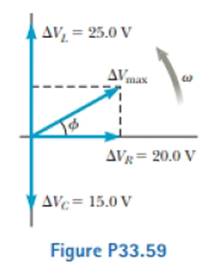
Review. The voltage phasor diagram for a certain series RLC circuit is shown in Figure P33.59. The resistance of the circuit is 75.0 Ω, and the frequency is 60.0 Hz. Find (a) the maximum voltage ΔVmax, (b) the phase angle ϕ, (c) the maximum current, (d) the impedance, (e) the capacitance and (f) the inductance of the circuit, and (g) the average power delivered to the circuit.

(a)
The maximum voltage.
Answer to Problem 33.59AP
The maximum voltage is
Explanation of Solution
Given info: The resistance of the circuit is
The expression for maximum value of the voltage is,
Here,
Substitute
Conclusion:
Therefore, the maximum voltage is
(b)
The phase angle.
Answer to Problem 33.59AP
The phase angle is
Explanation of Solution
Given info: The resistance of the circuit is
The expression for the phase angle is,
Substitute
Conclusion:
Therefore, the phase angle is
(c)
The maximum current.
Answer to Problem 33.59AP
The maximum current is
Explanation of Solution
Given info: The resistance of the circuit is
The expression for maximum current is,
Here,
Substitute
Conclusion:
Therefore, the maximum current is
(d)
The impedance.
Answer to Problem 33.59AP
The impedance is
Explanation of Solution
Given info: The resistance of the circuit is
The expression for the impedance is,
Substitute
Conclusion:
Therefore, the impedance is
(e)
The capacitance.
Answer to Problem 33.59AP
The capacitance is
Explanation of Solution
Given info: The resistance of the circuit is
The circuit is series
The expression capacitive reactance is,
Substitute
The expression capacitive reactance in terms of the capacitance is,
Here,
Rearrange the above equation for the value of capacitance.
Substitute
Conclusion:
Therefore, the capacitance is
(f)
The inductance of the circuit.
Answer to Problem 33.59AP
The inductance of the circuit
Explanation of Solution
Given info: The resistance of the circuit is
The circuit is series
The expression inductive reactance is,
Substitute
Thus the value of inductive reactance is
The expression inductive reactance in terms of the inductance is,
Here,
Rearrange the above equation for the value of inductance.
Substitute
Conclusion:
Therefore, the inductance is
(g)
The average power delivered to circuit.
Answer to Problem 33.59AP
The average power delivered to circuit is
Explanation of Solution
Given info: The resistance of the circuit is
The expression for R.M.S value of the current is,
The expression for the average power delivered is,
Substitute
Substitute
Conclusion:
Therefore, the average power delivered to circuit is
Want to see more full solutions like this?
Chapter 33 Solutions
EBK PHYSICS FOR SCIENTISTS AND ENGINEER
- No chatgpt plsarrow_forwardNo chatgpt plsarrow_forwardCar A starts from rest at t = 0 and travels along a straight road with a constant acceleration of 6 ft/s^2 until it reaches a speed of 60ft/s. Afterwards it maintains the speed. Also, when t = 0, car B located 6000 ft down the road is traveling towards A at a constant speed of 80 ft/s. Determine the distance traveled by Car A when they pass each other.Write the solution using pen and draw the graph if needed.arrow_forward
- In the given circuit the charge on the plates of 1 μF capacitor, when 100 V battery is connected to the terminals A and B, will be 2 μF A 1 µF B 3 µFarrow_forwardThe velocity of a particle moves along the x-axis and is given by the equation ds/dt = 40 - 3t^2 m/s. Calculate the acceleration at time t=2 s and t=4 s. Calculate also the total displacement at the given interval. Assume at t=0 s=5m.Write the solution using pen and draw the graph if needed.arrow_forwardThe velocity of a particle moves along the x-axis and is given by the equation ds/dt = 40 - 3t^2 m/s. Calculate the acceleration at time t=2 s and t=4 s. Calculate also the total displacement at the given interval. Assume at t=0 s=5m.Write the solution using pen and draw the graph if needed.arrow_forward
- The velocity of a particle moves along the x-axis and is given by the equation ds/dt = 40 - 3t^2 m/s. Calculate the acceleration at time t=2 s and t=4 s. Calculate also the total displacement at the given interval. Assume at t=0 s=5m.Write the solution using pen and draw the graph if needed. NOT AI PLSarrow_forwardThe velocity of a particle moves along the x-axis and is given by the equation ds/dt = 40 - 3t^2 m/s. Calculate the acceleration at time t=2 s and t=4 s. Calculate also the total displacement at the given interval. Assume at t=0 s=5m.Write the solution using pen and draw the graph if needed.arrow_forwardThe velocity of a particle moves along the x-axis and is given by the equation ds/dt = 40 - 3t^2 m/s. Calculate the acceleration at time t=2 s and t=4 s. Calculate also the total displacement at the given interval. Assume at t=0 s=5m.Write the solution using pen and draw the graph if needed.arrow_forward
- Please don't use Chatgpt will upvote and give handwritten solutionarrow_forwardNo chatgpt pls will upvote Already got wrong chatgpt answerarrow_forwardAn electron and a proton are each accelerated through a potential difference of 21.0 million volts. Find the momentum (in MeV/c) and the kinetic energy (in MeV) of each, and compare with the results of using the classical formulas. Momentum (MeV/c) relativistic classical electron proton Kinetic Energy (MeV)arrow_forward
 Physics for Scientists and Engineers, Technology ...PhysicsISBN:9781305116399Author:Raymond A. Serway, John W. JewettPublisher:Cengage Learning
Physics for Scientists and Engineers, Technology ...PhysicsISBN:9781305116399Author:Raymond A. Serway, John W. JewettPublisher:Cengage Learning Physics for Scientists and Engineers: Foundations...PhysicsISBN:9781133939146Author:Katz, Debora M.Publisher:Cengage Learning
Physics for Scientists and Engineers: Foundations...PhysicsISBN:9781133939146Author:Katz, Debora M.Publisher:Cengage Learning College PhysicsPhysicsISBN:9781285737027Author:Raymond A. Serway, Chris VuillePublisher:Cengage Learning
College PhysicsPhysicsISBN:9781285737027Author:Raymond A. Serway, Chris VuillePublisher:Cengage Learning
 Physics for Scientists and EngineersPhysicsISBN:9781337553278Author:Raymond A. Serway, John W. JewettPublisher:Cengage Learning
Physics for Scientists and EngineersPhysicsISBN:9781337553278Author:Raymond A. Serway, John W. JewettPublisher:Cengage Learning Physics for Scientists and Engineers with Modern ...PhysicsISBN:9781337553292Author:Raymond A. Serway, John W. JewettPublisher:Cengage Learning
Physics for Scientists and Engineers with Modern ...PhysicsISBN:9781337553292Author:Raymond A. Serway, John W. JewettPublisher:Cengage Learning





